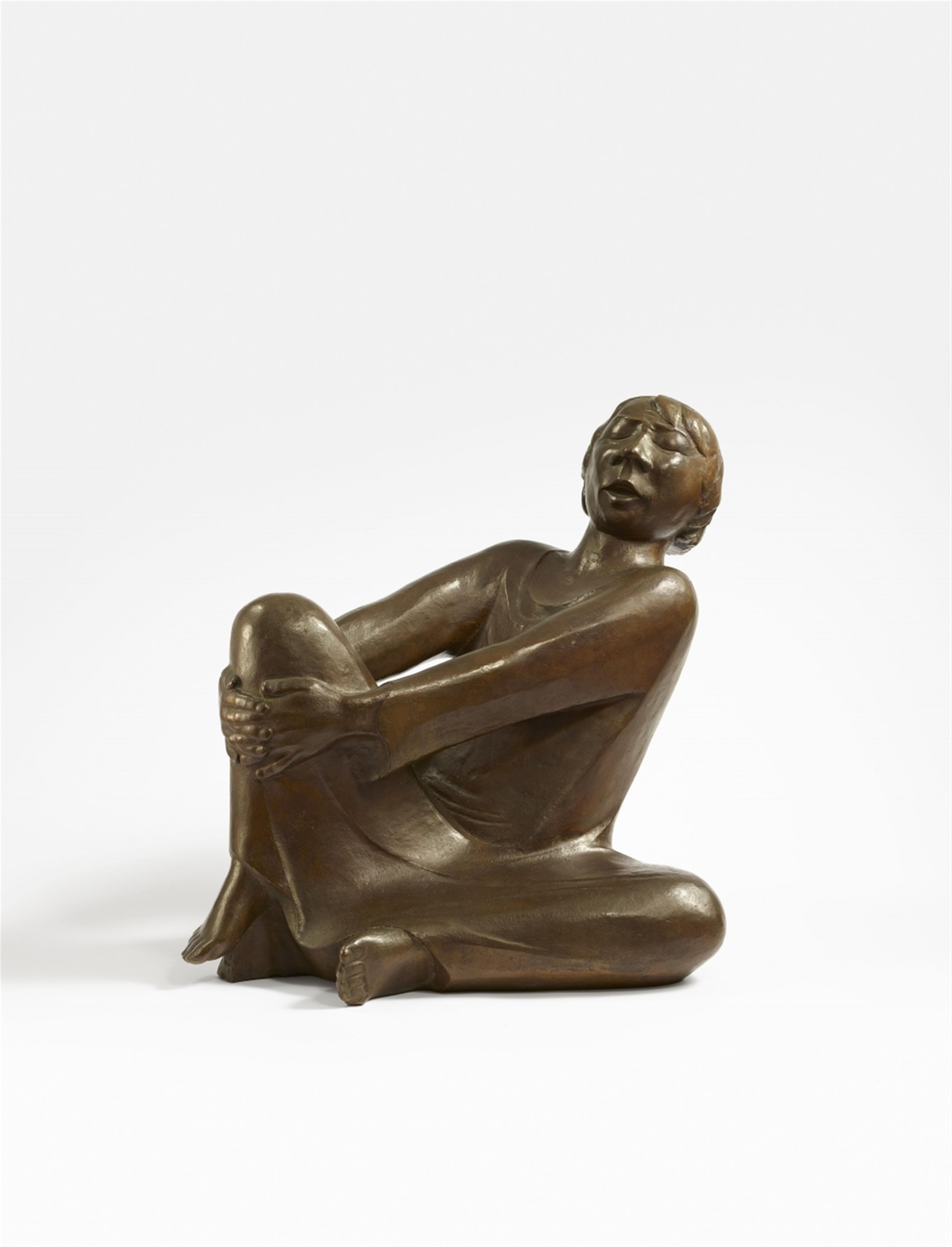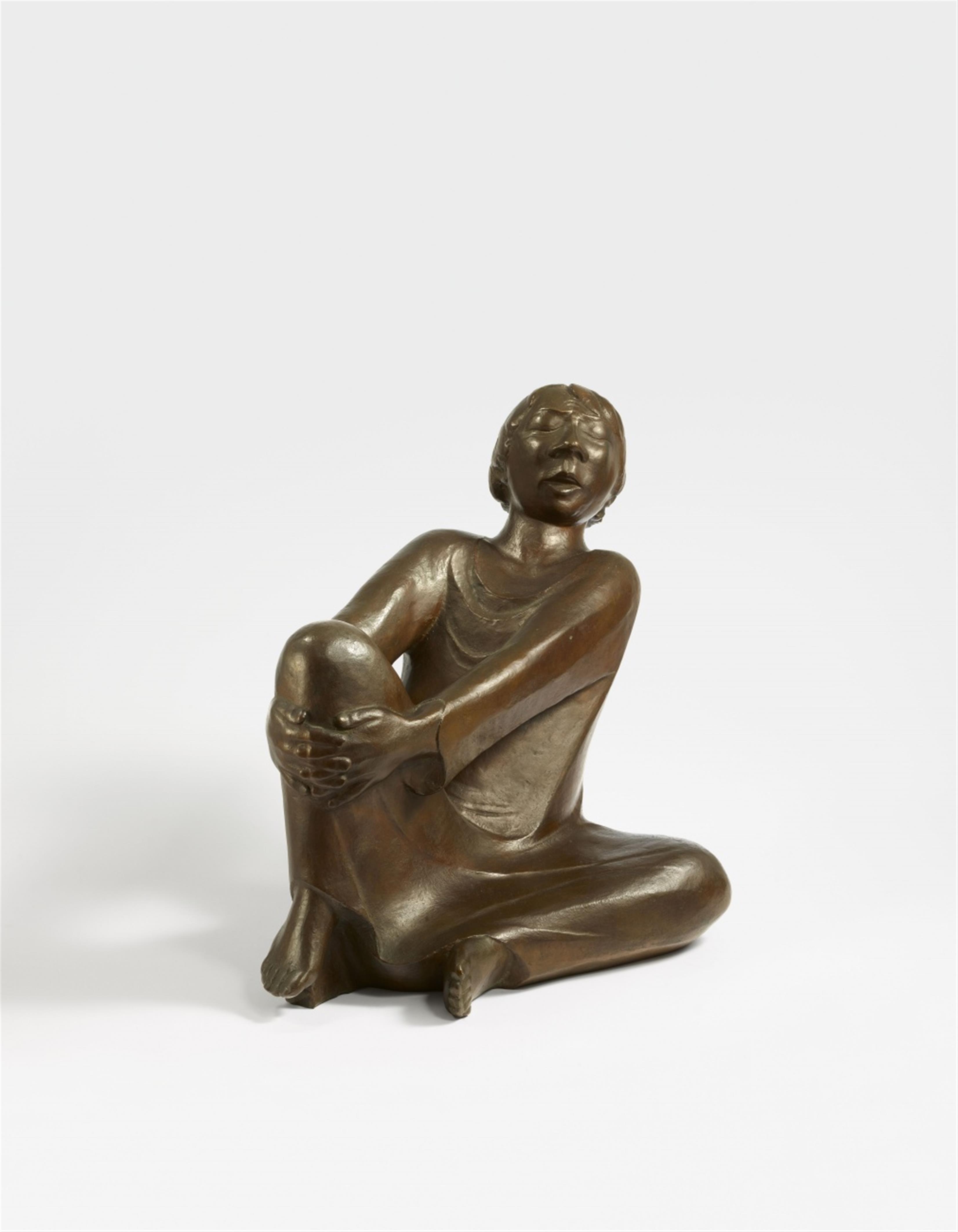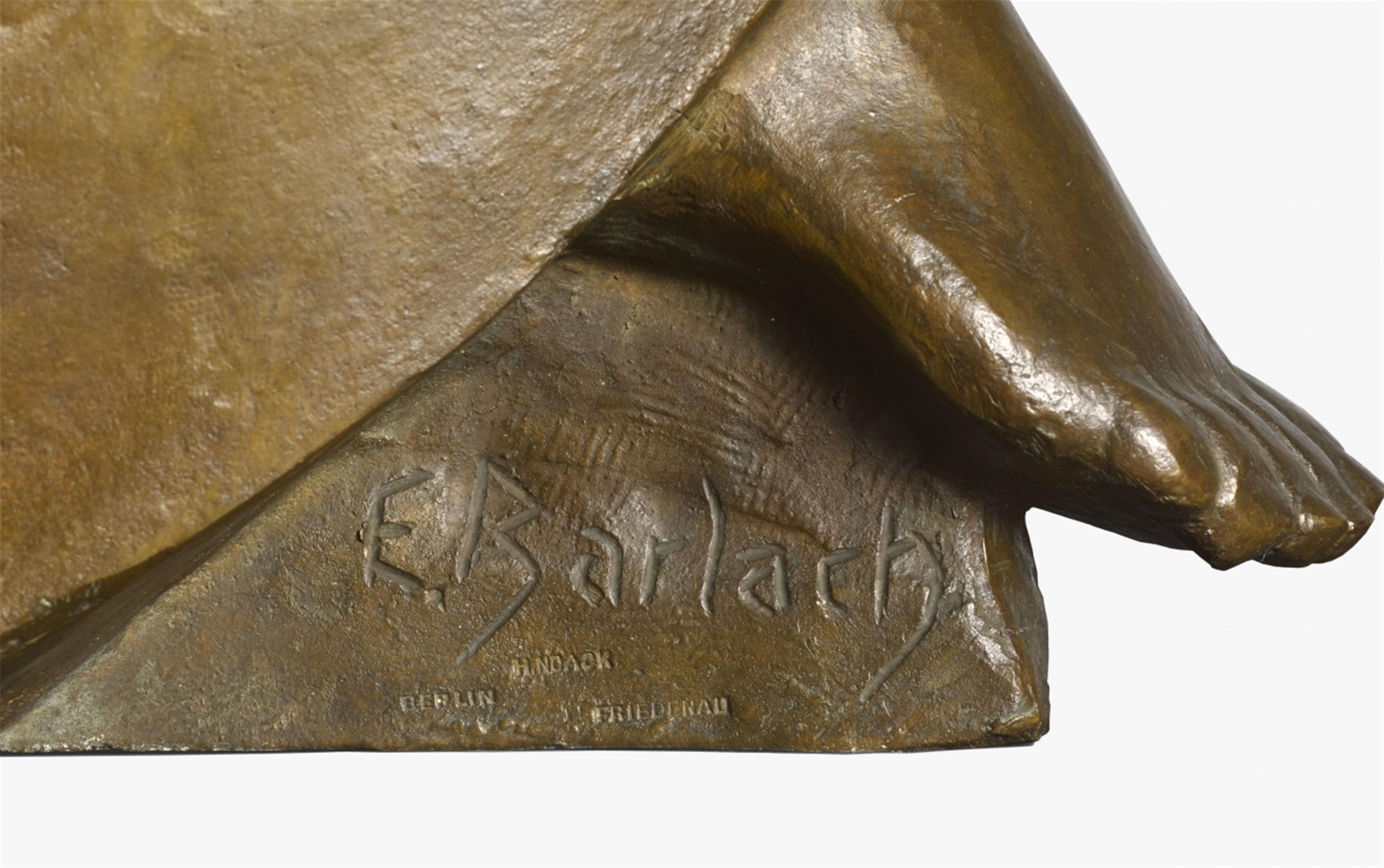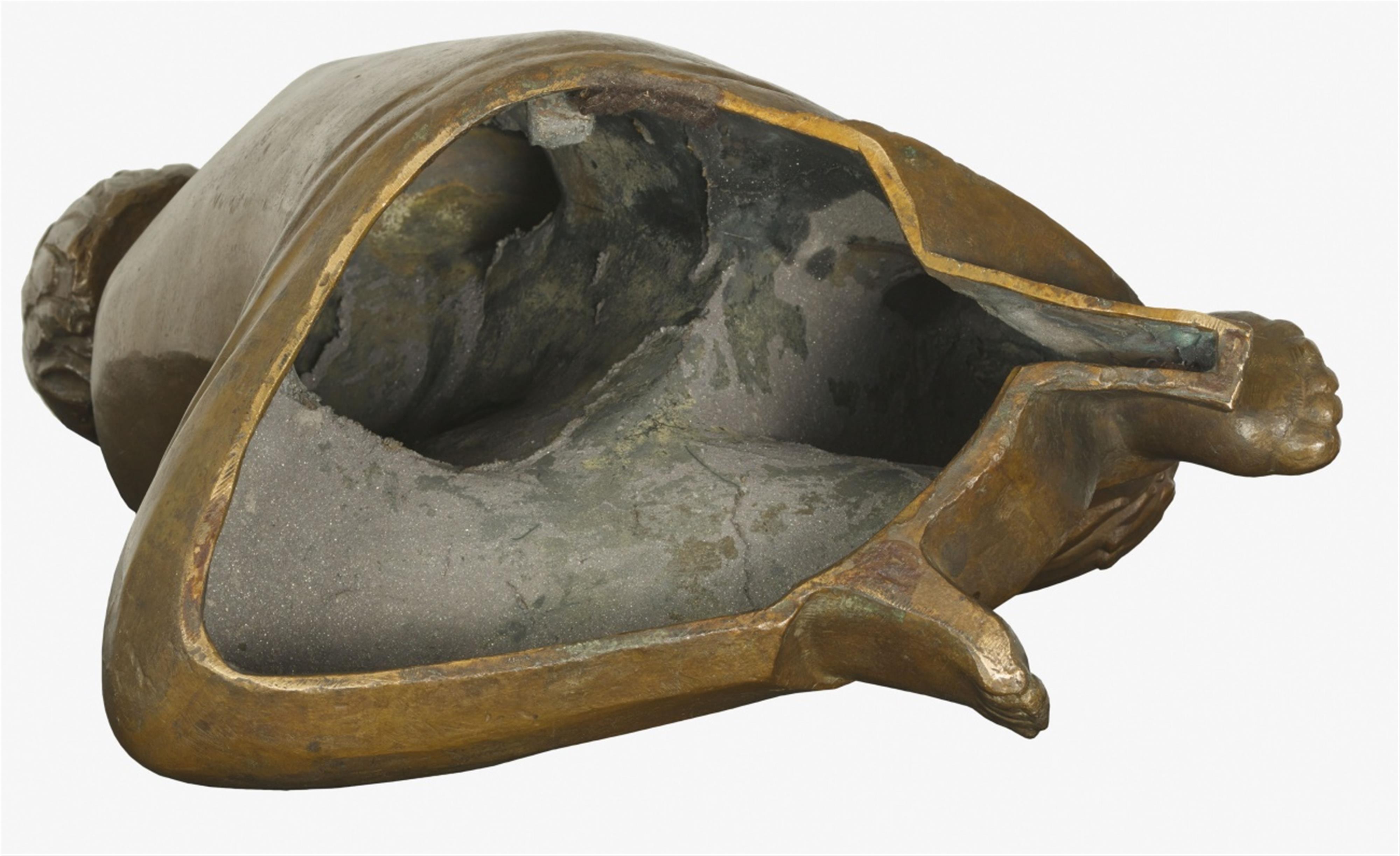Ernst Barlach
Der Singende Mann
1928
Bronze Height 49 cm Signed 'E. Barlach' and with the hammered foundry mark "H. NOACK BERLIN FRIEDENAU" on lower right side of footrest. One of a presumable total of 16 lifte-time casts. - Fine mid-brown patina with a tinge of olive, typical for the early casts.
Ernst Barlach's depictions of musicians present individuals in a state of absorption, meditatively and attentively listening inside themselves. “Der singende Mann”, presumably his most famous sculpture, surely represents this type more convincingly than any other sculpture by the artist: in a pose expressing tranquillity and composure, he concentrates on becoming aware of his inner experience. Together, the triangular composition and his gesture of relaxedly leaning back with closed eyes extend out into the surrounding space and form a stimulating contrast between expression and contemplation.
After the death of Barlach's friend and gallerist Paul Cassirer in 1926, the Berlin- and Düsseldorf-based art dealer Alfred Flechtheim represented the artist's interests and became an important supporter. Among other things, the cooperation between Barlach and Flechtheim involved an edition of ten casts of “Singender Mann”, which were completed by 1931 (see Lempertz Auction 1043, lot 213, result: € 688,000). Because these casts were quickly sold due to considerable demand, six additional ones were made during the artist's lifetime, and our cast featuring the “Friedenau” mark of the Noack foundry is one of these. The casting technique featuring hammered overflow channels provides further evidence for its early creation.
“Der singende Mann” has long been among the most sought-after sculptures of German Expressionism. On the one hand, the artist Barlach has succeeded in entirely timelessly capturing the man and his song in bronze and, on the other, he enables us to experience the sound of music in his visual art. The immense and still-enduring popularity of this masterpiece of modern sculpture may be explained not least by its joyous humanitas. The present cast from the artist's lifetime is to be seen as a rarity only seldom offered on the market.
Catalogue Raisonné
Laur 432; Schult I 343
Provenance
Ernst Stadelmann, Italy (German artist; Munich 1894-1972 Rome; relocation to Italy in the 1930s); Karl & Faber, Munich, Auktion 28 May 1991, lot 446 (consigned by Ernst Stadelmann's widow); Private collection, North Rhine-Westphalia; in family possession since
Literature
I.a. Alfred H. Barr, Omnibus, German Sculpture, Berlin/Düsseldorf 1932, p. 38-42; Marguerite Devigne, Ernst Barlach, in: Les Beaux-Arts, Brussels 1935, p. 14; Ernst Barlach, Ein selbsterzähltes Leben, Munich 1948, ill. 69; Carl Dietrich Carls, Ernst Barlach. Das plastische, graphische und dichterische Werk, 5th ed. Flensburg/Hamburg 1950, p. 58; Wolfgang Gielow, Ernst Barlach. Katalog der Plastik, Munich 1954, no. 252b; Paul Fechter, Ernst Barlach, Gütersloh 1957, p. 35; Friedrich Schult, Ernst Barlach. Das Plastische Werk, Hamburg 1960, no. 343; Franz Fühmann (ed.), Ernst Barlach. Das Wirkliche und Wahrhaftige, Wiesbaden 1970, p. 159; Bestandskatalog Skulptur-Plastik-Objekt, Kunsthalle Mannheim, Mannheim 1982, p. 65, no. 440; Meisterwerke des Expressionismus und der Klassischen Moderne, Museum am Ostwall, Dortmund 1985, p. 32 f.; Ulrich Bischoff (ed.), Katalog der Bildwerke aus dem Besitz der Kunsthalle zu Kiel, Rendsburg 1986, p. 30 f; Siegfried Gohr (ed.), Museum Ludwig Köln. Gemälde, Skulpturen, Enviroments vom Expressionismus bis zur Gegenwart. Bestandskatalog. Cologne 1986, p.19; Georg Syamken (ed.), Die Dritte Dimension. Plastiken, Konstruktionen, Objekte. Bestandskatalog der Skulpturenabteilung der Hamburger Kunsthalle, Hamburg 1988, p. 92; Helga Thieme, Ernst Barlachs Skulptur "Der singende Mann" in der Ausstellung "Neue deutsche Kunst", Oslo 1932, in: exhib. cat. Rostock 1998, p. 310 ff; Sabine Fehlemann (publ.), Ursula Frank (ed.), Von der Heydt-Museum Wuppertal, Skulpturensammlung. Neuauflage des Bestandskataloges von 1987, Wuppertal 2000, p. 32; Elisabeth Laur, Der Bildhauer als Buchkünstler, in: cat. Bremen 2001, p. 29; Jürgen Doppelstein, Heike Stockhaus (ed.), Ernst Barlach. Mystiker der Moderne. exhib. cat. Ernst Barlach Gesellschaft Hamburg, Hauptkirche St. Katharinen, Hamburg 2003, p. 201; Ursel Berger/Klaus Gallwitz/Gottlieb Leinz (ed.), Posthume Güsse. Bilanz und Perspektiven, Berlin/Munich 2009, p. 32 f., p. 106 f.
Exhibitions
I.a. Dresden 1931 (Galerie Ernst Arnold), Bronzen von Ernst Barlach; Oslo/Copenhagen/Cologne 1932, Nyere Tysk Kunst, cat. no. 6; Düsseldorf 1951 (Galerie Vömel), Ernst Barlach, no. 51; Recklinghausen 1963 (Städtische Kunsthalle Recklinghausen), Kunstwerke aus drei Jahrtausenden gesammelt im Ruhrgebiet, cat. no. 68; Hamburg 1977 (Ernst Barlach Haus), Stiftung Herrmann F. Reemtsma, Plastiken, Handzeichnungen und Autographen, ed. by Isa Lohmann-Siems, Gunhild Roggenbuck, cat. no. 53; Bergen/Güstrow 2000 (Bergen Kunstmuseum/Ernst Barlach Stiftung Güstrow), Ernst Barlach. Ein Graphiker und Bildhauer des deutschen Expressionismus, edited by Helga Thieme, ed. by Elisabeth Laur, no. 92; Kyoto 2006 (The National Museum of Modern Art/The University Art Museum/Yamanashi Prefectural Museum of Art, Kofu), Ernst Barlach Retrospektive, no. 145








